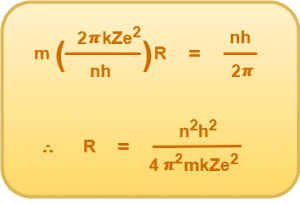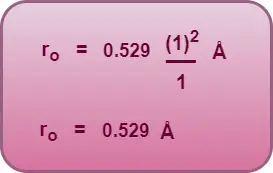Radii of Permitted Orbits-
Before you go through this article, make sure that you have gone through the previous article on Bohr’s Atomic Model.
We have learnt that-
- Electrons revolve around the nucleus in fixed energy orbits called as stationary states.
- Of all the possible circular orbits, an electron revolves only in those circular orbits in which its angular momentum is an integral multiple of h/2π.
In this article, we will derive the expression for the radii of permitted orbits.
Deriving Expression For The Radii of Permitted Orbits-
Consider a single electron species having atomic number Z. It consists of a nucleus with a charge +Ze and a single electron of charge -e which revolves around it in a circular orbit of radius R with a speed v.

To keep the electron in its orbit, the centripetal force on this electron must be equal to the electrostatic force of attraction between the nucleus and the electron. So, we must have-

By Bohr’s quantization condition of angular momentum, we know-

From equations (1) and (2), we have-

Using equation-(3) in equation (2), we get-

This is the required expression for the radius of nth orbit.
On substituting the values of known constants in the above expression, we get-

This is the simplified expression for the radius of nth permitted orbit.
For hydrogen atom (Z=1),
- Radius of 1st orbit = 0.529 (1)2 = 0.529 Å
- Radius of 2nd orbit = 0.529 (2)2 = 2.116 Å
- Radius of 3rd orbit = 0.529 (3)2 = 4.761 Å
- Radius of 4th orbit = 0.529 (4)2 = 8.464 Å and so on….
Important NoteIt is important to note that the radii of permitted orbits are proportional to n2 and increase in the ratio of 1:4:9:16 and so on. |
Bohr’s Radius-
The radius of the innermost orbit of the hydrogen atom is called as Bohr’s radius denoted by ro.
For Bohr’s radius, put Z = 1 and n = 1 in the above expression, then-

This is the expression for Bohr’s radius.
Read the next article on-
Speed of Electron in nth Bohr Orbit
Get more notes & other study material of the Chapter Atoms.

